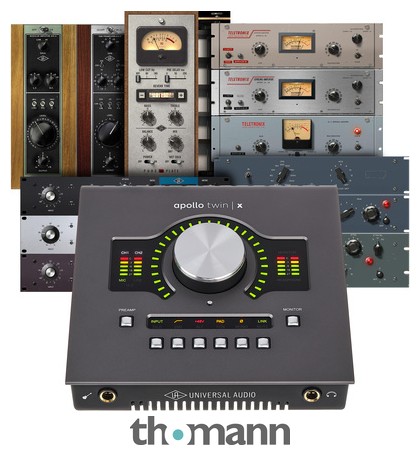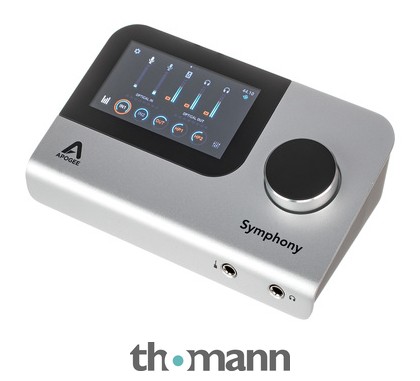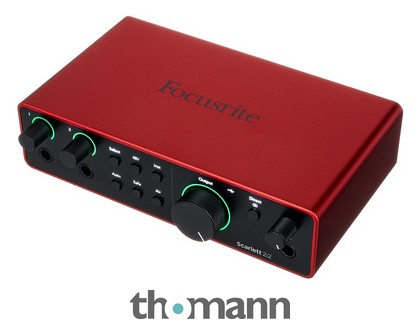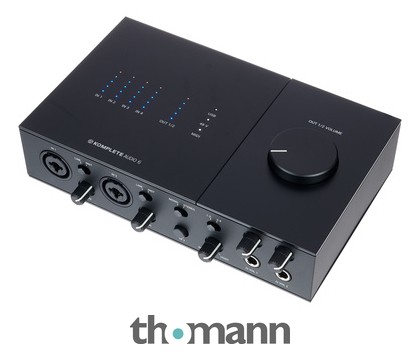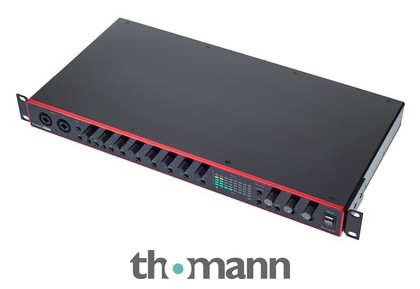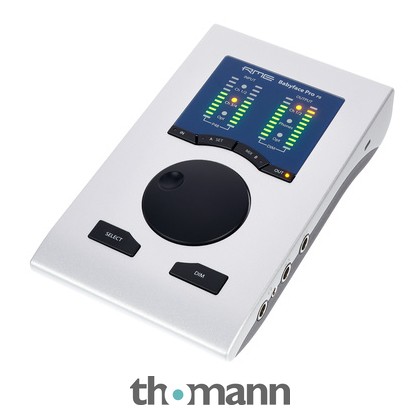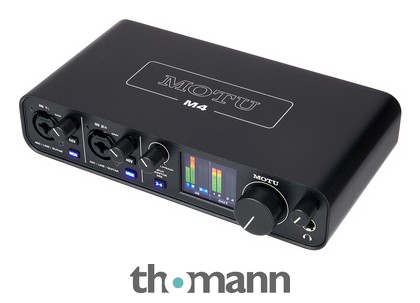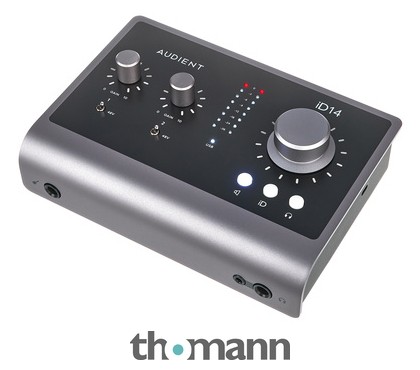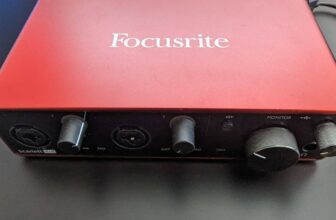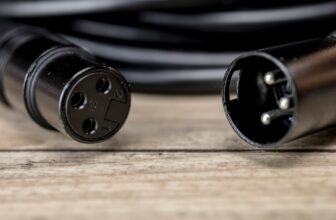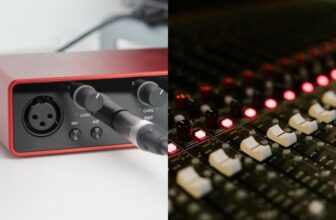The 10 Best Audio Interfaces (2024)
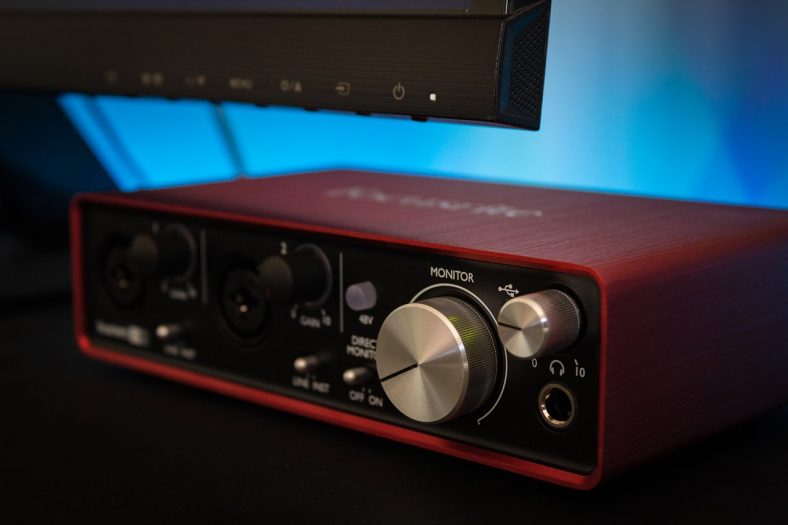
Audio interfaces are essential to any studio, either in the professional recording and mixing houses or home studio setups. From entry-level budget-friendly to professional large multi-functional audio interfaces, it can be a bit tricky to decide which one to buy.
To make it easier for you to find the right audio interface for your project, I have selected some of the best audio interfaces for different needs and budgets.
My top recommended audio interface is the Universal Audio Apollo Twin X DUO Heritage Edition, which shines with its high versatility and great audio quality.
For a tighter budget, I recommend the Focusrite Scarlett 2i2 4th Gen, a cost-effective audio interface with high popularity among home studio setups.
Contents
- The Best Audio Interfaces (2024) – At A Glance
- 1. Universal Audio Apollo Twin X DUO Heritage Edition
- 2. Focusrite Scarlett 2i2 4th Gen
- 3. Apogee Symphony
- 4. Native Instruments Komplete Audio 6 Mk2
- 5. PreSonus Studio 68c
- 6. Focusrite Scarlett 18i20 3rd Gen
- 7. Behringer U-PHORIA UMC404HD
- 8. RME Babyface Pro FS
- 9. MOTU M4
- 10. Audient iD14 MKII
- What is an Audio Interface and how does it work?
- How many inputs/outputs do you need in an Audio Interface?
- What is the difference between conventional Audio Interfaces and USB Audio Interfaces?
- Should you buy an Audio Interface or Mixing Board?
- How to set up an Audio Interface?
- What to look for in an Audio Interface when buying?
- Conclusion
The Best Audio Interfaces (2024) – At A Glance
And now onto the full list:
1. Universal Audio Apollo Twin X DUO Heritage Edition
One of the best-selling audio interfaces today is the Universal Audio Apollo Twin X DUO Heritage Edition, which catches the eye with its great audio quality, compact design, and great UAD plugins. It is a 2-in/-6-out interface with 24-bit/192kHz capabilities.
Pros
- Great audio quality
- Compact design
- Durable construction
- UA plugins system
Cons
- No MIDI option
- Pretty pricey
- No thunderbolt cable included
The unit features two preamps with XLR and ¼” combo inputs for mics or instruments. Plus, it has an optical cable on the back side to expand the input range whenever necessary. On the control panel, you find a very large volume knob, mono switch, dim switch, and talkback buttons.
The specialty of this audio interface is the UA interface, which features a processor that runs UA plugins, emulations of preamps, EQs, reverbs, compressors, and so on. As a bonus, the interface handles the processing of these emulations, taking the load off your computer or laptop.
| Compatibility | PC, Mac |
| Connectors | 1 x USB-C (Thunderbolt 3), 2 x XLR-1/4″ combo (mic/line), 1 x 1/4″ (Hi-Z), 2 x 1/4″ (monitor), 2 x 1/4″ (line out), 1 x Optical Toslink (ADAT,S/PDIF), 1 x 1/4″ TRS Headphones |
| Software Included | UAD Realtime Analog Classics plug-ins (VST, AU, AAX 64), 5 Heritage Edition plug-ins |
| Phantom Power | Yes |
| Microphone Preamps | 2 |
| Other Features | UAD-2 Duo Core ProcessingRealtime UAD Powered Plug-ins |
In short, Universal Audio Apollo Twin X DUO Heritage Edition is one of the best audio interfaces for home studios with its compact, feature-packed design and great sonic performance.
2. Focusrite Scarlett 2i2 4th Gen
Focusrite Scarlett 2i2 4th Gen is one of the most popular audio interfaces today, thanks to its simple and cost-effective design, great audio and build quality as well as its versatility. It combines everything you need to get started producing or recording music.
Pros
- Great value for the price
- Compact design
- Great software bundle
- Air preamp emulation
- Ultra-low-noise preamps
Cons
- No MIDI 5-pin jack
- Air Feature is a bit useless
- Doesn’t quite match the quality of the higher end interfaces on this list
Focusrite Scarlett 2i2 4th Gen features dual channels with ultra-low-noise mic preamps and comes equipped with a great range of software bundles, including Focusrite Control 2, Ableton Live Lite, and a 3-month Avid Pro Tools Artist.
It is compatible with Windows and Macs with its USB 2.0 connector as well as with iOS devices like iPad Pros. Plus, it has an air preamp emulation system which provides a brighter sound with higher-frequency EQ. The air mode is decent for vocal recordings but does not make a huge difference, in my opinion.
| Compatibility | Mac, PC, ChromeOS |
| Connectors | 2 x XLR, 2 x 1/4″ inputs, 2 x 1/4″ outputs, 1 x 1/4″ headphone out, 1 x USB Type C |
| Software Included | Focusrite Control 2, Ableton Live Lite, 3-month Avid Pro Tools Artist |
| Phantom Power | Yes |
| Microphone Preamps | 2 |
| Other Features | None |
Overall, for the price, Focusrite Scarlett 2i2 4th Gen is one of the best audio interfaces you can find and is ideal as the first audio interface for a musician.
If you want something more affordable, you can check out the Focusrite Scarlett 2i2 4th Gen, a very popular audio interface, thanks to its great value-for-price ratio and simplistic design.
3. Apogee Symphony
Suppose you are looking for a high-end audio interface for your home setup. In that case, Apogee Symphony is one of the ideal choices. It’s feature-packed, superlative audio quality with two great preamps, easy to use with the LCD touchscreen, and versatile due to its hardware DSPs and a handful of DSP-accelerated plug-ins.
Pros
- High versatility with the feature-packed design
- Superlative audio quality
- Great range of input-output options
- DSP processing
- LCD touchscreen for ease of use
Cons
- Pricey
Apogee Symphony is designed to be used in home studios with its portable tabletop form and a great LCD touchscreen on top for ease of navigation. Plus, it is equipped with the real-time DSP bundle with great-sounding plugs.
There is a wide range of input-output options, including 2 XLR-1/4″ combo mic-line input. Connecting to a computer or smart device is possible via USB-C or USB-A. It also has optical in and out options.
The sound quality the device provides plays a big role in the high-performance of the device. The resolution is up to 24-bit/192kHz, and the 2 built-in Advanced Stepped Gain Architecture preamps provide up to 75 dB of gain without any distortion.
| Compatibility | PC, Mac |
| Connectors | 2 x XLR-1/4″ combo (mic/line), 1 x 1/4″ (Hi-Z), 2 x 1/4″ (L/R), 1 x Optical Toslink (ADAT, S/PDIF), 1 x 1/4″ and 1 x 1/8″ Headphones jack, 1 x USB Type A, 1 x USB-C |
| Software Included | Symphony Desktop Control Application |
| Phantom Power | Yes |
| Microphone Preamps | 2 |
| Other Features | Built-in DSP Processing, Mic Pre Emulations, Symphony ECS Channel Strip, LCD touchscreen |
If you are after professional-quality audio projects in your home studio, I highly recommend you check out Apogee Symphony.
4. Native Instruments Komplete Audio 6 Mk2
Native Instruments Komplete Audio 6 Mk2 is another cost-effective audio interface aimed at entry-level musicians. It comes with a wide range of input-output options, a great software bundle including Ableton and Native Instruments Suite, a sleek and sturdy design, and good driver and audio performance.
Pros
- Sturdy construction
- Great software bundle
- Wide range of input-output options
- Two headphone ports with separate controls
Cons
- No gain controls for all inputs
- Only headphones as monitor outputs
The eye-catching features of Native Instruments Komplete Audio 6 Mk2 are the separate control options for the dual headphone ports and the software bundle that includes two of the essential DAWs.
The USB-powered interface features 4 analog mic and instrument inputs, 4 balanced analog outputs, and digital stereo input and output. Plus, there is also the MIDI in-out connector.
| Compatibility | PC, Mac |
| Connectors | 2 x XLR-1/4″ combo (mic/line), 2 x 1/4″ TRS (line), 4 x 1/4″ TRS (DC coupled), 1 x Coax (S/PDIF), 2 x 1/4″ Headphones jack, 1 x USB Type B 2.0 |
| Software Included | Native Instruments Suite, Ableton Live 10 Lite |
| Phantom Power | Yes |
| Microphone Preamps | 2 |
| Other Features | None |
The audio interface has all you expect from a decent audio interface with many bonuses. For tighter budgets and entry-level music producers, it is a great option.
5. PreSonus Studio 68c
PreSonus Studio 68c shines with its durable all-rounder design that can get the job done for home studios for entry-level musicians when recording or producing music. It is not the best and most versatile audio interface, but it is a great starting point for most musicians.
Pros
- Great PreSonus’ XMAX solid-state preamps
- Durable
- Good software bundle
- Loopback function
Cons
- Not USB-powered
- Does not have separate phantom power switches
The 6-in/6-out USB-C audio interface is equipped with 4 high-quality XMAX Class A microphone preamplifiers, which is the device’s best feature. On the control panel, you will find LED meters showing levels. Furthermore, there is a good range of connection options and low-latency monitoring, which is great for live performances.
On the drawback side, the device is not USB-powered, so you will need an electric source you can connect to with an adapter. Additionally, the phantom power switch for condenser mics is not separate for different inputs: It can be switched on or off for all of them simultaneously.
| Compatibility | PC, Mac |
| Connectors | 2 x XLR-1/4″ combo (mic/line/Hi-Z), 2 x XLR-1/4″ combo (mic/line), 2 x 1/4″ (main out), 2 x 1/4″ (line), 1 x 1/4″ Headphones jack, 1 x USB Type C, 1 x DB-9 Midi (in/out) |
| Software Included | Studio One Artist, Studio Magic Plug-in Suite |
| Phantom Power | Yes |
| Microphone Preamps | 4 |
| Other Features | Level metering screen, loopback channel |
Overall, PreSonus Studio 68c is a decent audio interface to step into the music production world. It is fairly priced and has good quality audio with great drivers and enough versatility to help you with any kind of home studio project.
6. Focusrite Scarlett 18i20 3rd Gen
If you are looking for a big audio interface with plenty of channels and inputs, Focusrite Scarlett 18i20 3rd Gen might be the ideal choice for you. It is equipped with eight XLR inputs, optical and S/PDIF connections, and ten line-outs in total, along with 8 Scarlett mic preamps.
Pros
- Wide range of inputs-output options
- Relatively affordable
- Very low latency
- Rugged construction
- Great software bundle
Cons
- Chunky product
Focusrite Scarlett 18i20 offers plenty of possibilities with its feature-packed design. The drivers provide high-performance up to 24-bit/192kHz resolution, and the latency is quite low, which is great for monitoring.
The device is quite large, as you’d expect from an audio interface with so many channels and connectors. It is not recommended if you will be solely recording single instruments or vocals. But, if you want to record a band or drums, it might be the best choice for the price range.
| Compatibility | PC, Mac |
| Connectors | 2 x XLR-1/4″ combo (mic/Hi-Z), 6 x XLR-1/4″ combo (mic/line), 10 x 1/4″ (line out), 1 x Coax (S/PDIF), 2 x Optical (ADAT), 2 x 1/4″ Headphones jack, 1 x Type USB-C |
| Software Included | Ableton Live Lite, Plug-in Collective access, Hitmaker Expansion Bundle, 3-month Avid Pro Tools Subscription |
| Phantom Power | Yes |
| Microphone Preamps | 8 |
| Other Features | LED level metering |
The software bundle is also great to get you started with Ableton, Pro Tools, and extra plug-ins. Besides its versatility, this unit is also quite affordable, which is why it is so popular.
7. Behringer U-PHORIA UMC404HD
Behringer U-PHORIA UMC404HD is a well-rounded audio interface with four high-quality preamps for XLR or 1/4” inch cables. It is not a very versatile unit, but it is great for recording bands, drums, and vocals. Plus, it has one of the lowest price tags in the market.
Pros
- Great value for the price
- Very low latency
- Inserts to use the unit with outside gear
Cons
- Does not come with any software bundle
Behringer U-PHORIA comes equipped with inserts that allow you to use outside gear like EQ or compressors with the unit. With these inserts, the signal goes to the outside gear before traveling to the DAW when needed.
The preamps are high-performing, and they come with a pad to turn down the gain on the mics for recording loud gear like drums or guitar amps. This is the area where Behringer U-Phoria shines.
| Compatibility | PC, Mac |
| Connectors | 4 x XLR/TRS Combo, 4 x 1/4″ (Inserts), 6 x 1/4″, 2 x XLR, 2 x Stereo, 1 x 1/4″ Headphone Jack |
| Software Included | None |
| Phantom Power | Yes |
| Microphone Preamps | 4 |
| Other Features | None |
In short, Behringer U-PHORIA offers great value for musicians with a tight budget who want to record music.
8. RME Babyface Pro FS
RME Babyface Pro FS is a 12-in/12-out portable USB 2.0 audio interface with high-quality construction and sleek design. It comes with 2 digitally controlled microphone preamps, 4 inputs, and a great software bundle.
Pros
- Great audio quality and signal stability
- Feature-packed design
- Low latency
- Durable construction
- Premium plug-in and software bundle
Cons
- Pricey
RME Babyface Pro FS shines with the signal stability and low latency it provides. High-quality drivers, circuits, and parts such as SteadyClock/femtosecond increase the signal, audio quality, and stability while decreasing latency.
Each interface channel features latency-free processing, including a 3-band EQ, low-cut filter, reverb, and echo. The software bundle is quite great and rich with RME TotalMix FX and extra plug-ins. The unit works with iOS devices like iPhones as well as PCs and Macs. There are different software for each platform.
| Compatibility | PC, Mac, iOS |
| Connectors | 2 x XLR (mic), 2 x 1/4″ (Hi-Z/line) ,2 x XLR (+4dBu/+19dBu) ,1 x Optical Toslink (ADAT, S/PDIF) ,1 x 1/4″ and 1 x 1/8″ Headphones jack ,1 x USB Type B |
| Software Included | RME TotalMix FX, Total Mix Remote (iOS, Mac, PC) ,Brainworx Plug-ins ,Scuffham S-Gear Amp Collection |
| Phantom Power | Yes |
| Microphone Preamps | 2 |
| Other Features | Multifunctional LED display |
9. MOTU M4
MOTU M4 is another great option for home studios of entry-level musicians. The 4-in/4-out USB-C Audio Interface features 2 Microphone Preamps, an LCD Screen, a hardware monitoring system, a loopback, and 6+GB of the free plug-in content.
Pros
- Great entry-level audio interface with simplistic design
- Loopback channel
- Good range of inputs and outputs
- Low latency
- LCD screen for metering
- Good software bundle
Cons
- Not the best headphones amp
- No optical inputs or outputs
The Motu M4 has ESS Sabre32 Ultra DAC technology for 120dB of dynamic range and superb audio quality. The latency is as low as 2.5ms at 24-bit/96kHz with a 32-sample buffer, which is great, especially for the price range.
The full-color LCD screen helps a lot for level metering, and 2 built-in preamps deliver high-quality audio with individual gain adjustments. The unit also has a loopback for podcasting and live streaming.
| Compatibility | PC, Mac |
| Connectors | 2 x XLR-1/4″ TRS (mic/line/Hi-Z), 2 x 1/4″ (line), 2 x 1/4″ TRS (DC coupled, monitor), 2 x 1/4″ TRS (DC coupled, line), 1 x Dual RCA Stereo (monitor), 1 x Dual RCA Stereo (line), 1 x 1/4″ Headphones jack, 1 x USB-C |
| Software Included | MOTU Performer Lite, Ableton Live 10 Lite, Bundled Loops/Sounds |
| Phantom Power | Yes |
| Microphone Preamps | 2 |
| Other Features | Full-color LCD screen, Loopback channel |
Overall, Motu M4 is a portable and great-performing audio interface for home studios and novice musicians. For the price range, you get big versatility and quality, allowing you to step into the production and recording world.
10. Audient iD14 MKII
Audient iD14 MKII catches the eye with its compact and elegant design. The 10-in/6-out USB-C audio interface with 2 Audient class A console mic preamplifiers with phantom power, a JFET DI, 4 line outputs, ADAT optical input, bus power, and 2 headphone outputs along with the ARC software suite.
Pros
- Great sound quality with preamps and JFET input
- Looks great
- Further customization options with the ID app
- Loopback channel
- Desktop form
Cons
- Needs USB 3.0 connection for optimal performance
- No hardware input monitoring
- No separate headphone levels
The audio interface features a great audio performance with high-quality preamps and JFET inputs. The rugged, attractive, all-metal chassis features the ScrollControl, which lets you use the iD14 MKII’s big volume knob to tweak DAW/plug-in parameters. Plus, it has low-latency monitoring, and the desktop form design is highly convenient.
On the downside, the audio interface uses USB 3.0 and needs USB 3.0 support for optimal performance without latency. The lack of hardware input monitoring and separate headphone level adjustment options are some details that could be improved.
| Compatibility | PC, Mac |
| Connectors | 1 x 1/4″ (instrument), 2 x XLR-1/4″ combo (mic/line), 4 x 1/4″ (2 x stereo), 1 x Optical Toslink (ADAT), 1 x 1/4″ and 1 x 1/8″ Headphones jack, 1 x USB-C |
| Software Included | ARC software suite |
| Phantom Power | Yes |
| Microphone Preamps | 2 |
| Other Features | Loopback channel |
To summarize, Audient iD14 MKII is a highly versatile audio interface with premium quality sound and an elegant design. It is a great choice for musicians who want the best performance possible in their home studios without breaking the bank.
What is an Audio Interface and how does it work?
Audio interfaces are the heart of a studio setup as they convert mic and instrument signals into a format that computers can understand. This way, the analog signals are translated into digital audio signals, which you can manipulate in software programs called DAWs.
Audio interfaces are a must for recording, producing music, or using plug-ins to add effects to your tone.
How many inputs/outputs do you need in an Audio Interface?
The amount of inputs-outputs musicians need in an audio interface depends on the needs of individuals. For bedroom producers and home studios, 2 inputs might be enough, while at least 8 channels are recommended for professional studios.
Another important factor is which instrument you want to record. For vocals or guitar recording, 2 inputs are more than enough, but if you want to record drums, you will need more inputs around 8. For live recording bands, you might need even more inputs.
The types of inputs are also important. There are four main input types. Mic input for microphones, line inputs for instruments such as bass and guitars, and MIDI inputs for recording MIDI instruments and synths.
There are also line outputs for studio monitors and MIDI outputs for MIDI devices. Audio interfaces also have headphone jacks for headphone monitoring.
What is the difference between conventional Audio Interfaces and USB Audio Interfaces?
USB audio interfaces use the USB connection for signal transfer, while conventional audio interfaces, which are very rare these days, use different kinds of connections like PCIe (PCI Express or FireWire. Performance-wise, USB audio interfaces today are more convenient, comfortable, and better.
Should you buy an Audio Interface or Mixing Board?
Audio interfaces are more affordable and higher-performing when it comes to recording and producing music. However, if you want to mix audio inputs for a live performance or use any kind of live application, a small mixing console can be a better choice for you.
Mixers are more suited for live applications for mixing audio characteristics while audio interfaces are more versatile and can be used for recording, music production as well as live recordings to some extent. There are also high-end devices that are mixers, converters, and audio interfaces at the same time.
How to set up an Audio Interface?
Setting up an audio interface is pretty easy. First, you need to connect the unit to your computer and to the electric source if necessary, and then install the interface drivers to your computer that comes with the unit. After the installation, you are ready to use your DAW through your audio interface.
What to look for in an Audio Interface when buying?
When buying an audio interface, you need to check the input-output amount and types, compatibility, connection type, and price. Depending on your needs, these are the crucial elements you should check to find the ideal audio interface for your projects.
Input and output amount and type depend on where you will be using the unit and which instruments you will record. For a basic home studio for guitar and vocal recording, a 2-channel audio interface would be enough. In contrast, for drum or full band recording in a professional setting, you will need at least 8 inputs.
The compatibility is another important detail as the audio interface has to support the operating system. Some audio interfaces work only on Mac, while some work only on Windows, and some are compatible with smart devices while some aren’t.
The connection type is also crucial. Audio interfaces have Thunderbolt, USB, Firewire, and PCle connection options. The most common ones are thunderbolt and USB audio interfaces, universal connection types. I recommend sticking to them.
Finally, the price is also important. You do not have to spend a fortune on an audio interface if you just step into the music production world. It is better to start with something basic and go for a better one later when you learn all the details and tricks of music production so that you can take advantage of all the great features of higher-end audio interfaces.
Conclusion
Audio interfaces are the heart of the music production world and are the most crucial members of studio setups. There are many options today with different features ideal for different kinds of projects, from podcasting to vocal recording, from guitar recording to music production with MIDI devices.
The list has some of the most cost-effective audio interfaces on the market today that you can check out and use for different projects.
My top recommended audio interface is the Universal Audio Apollo Twin X DUO Heritage Edition, as it provides great audio quality with its compact and feature-packed design.
If you want something more affordable, you can check out the Focusrite Scarlett 2i2 4th Gen. The most popular audio interface, thanks to its great value-for-price ratio and simplistic design.

